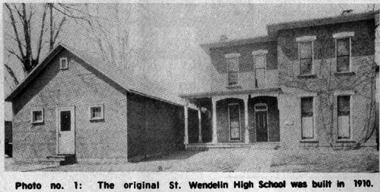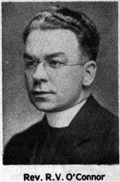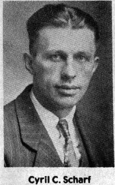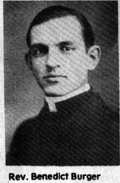April 16, 1981




Picture #1 – The original St. Wendelin High School was built in 1910
Picture #2 – Rev. R.V. O’Connor
Picture #3 – Cyril C. Scharf
Picture #4 – Rev. Benedict Burger
Picture #5 (missing) – Rev. A.A. Weber
Author’s Note: Today’s article is a continuation of the St. Wendelin story from last week. Even with the condensation and two installments, it was necessary to eliminate material which would have provided interesting reading. Sorry!
During more recent years, a new convent was built at Wood and Fremont streets to house the Sisters of Notre Dame. The site was previously the historic Mickey home, which older readers will remember. Also, more recently the interior of the church was remodeled and redecorated.
So, from a humble beginning with a few people in the 1840s, to 16 families in 1865, 3,700 members in 1952, 6,000 members in 1958, and presently a membership of 7,528…St. Wendelin has continued to grow and serve those of Catholic faith in Fostoria and surrounding areas, including: Bradner, Wayne, Jerry City, Bloomdale, Risingsun, West Millgrove, Arcadia and the adjacent rural areas.
SCHOOL HISTORY
As the church has grown, so has their educational facilities. Today, their elementary school has an enrollment of 613…all starting from that first frame structure originally used as a church, on the land donated by C.W. Foster.
St. Wendelin High School has had an interesting history, starting in 1910, when it began as a two-year commercial school, and continuing until a four- year school with a varied curriculum was offered in 1920. In 1924, college prep, general and commercial courses were offered. All of that time, 1910- 1920, the school was located at Wood and College streets (See Photo No. 1).
In 1929, when Rev. Benedict Burger was an assistant priest and also involved in the school system, a need for a new high school became imminent. Burger was active in laying the groundwork for getting the new school. He drowned at an outing at Lake Erie in 1926, but Rev. Robert O’Connor continued with the project.
The new high school was completed in 1930, and that year had 108 students. Since then the school has been enlarged and the enrollment this year is 271.
Rev. Burger was so well thought of among the Catholic parishioners and throughout Fostoria, that at the time of his death, the staff of The Wendelette published a commemoration booklet, in which many lauded his contribution to his church and the city. There is much interesting information in that booklet, and others, about the Catholic church in Fostoria and many of it members who have contributed to the growth and welfare of our town.
BURYING GROUNDS
Mention should be made of the church’s various burying grounds. When C.W. Foster donated the acre of ground to the early Catholics for a church, they designated a part of the plot for their first cemetery. It was south of the present church. When the LE & W Railroad layed their tracks through that area in 1858, the three bodies which had been buried there were removed to a new cemetery on Buckley Street, where the city tennis courts are today. Some of us older Fostorians remember it, with the fence around it. It remained as a desolate spot for many years.
Then in 1889, the Buckley Street cemetery was abandoned, when the Catholics purchased the land where their cemetery is now, on Van Buren Street, and again the bodies were moved to the present location.
PEOPLE REMEMBERED
Your ‘Potluck’ editor always tries to get reader viewpoints and recollections, which I did in writing this article.
The memories which Mabel Myers, a senior citizen at St. Wendelin shared with me were both pleasant and informative. A convert to Catholicism, Mrs. Myers had been taking instructions under Father Burger. She was baptized and received her first communion by Burger on Wednesday, July 7, 1926. Burger drowned the next day at a Lake Erie outing of young people from the parish. His body was not recovered until the following Sunday, relatively close to shore. Mrs. Myers’ husband, Carl, drug the body from the discovery spot to shore.
Another senior citizen family which I visited was Mr. and Mrs. Paul Magers. They have many happy memories of their family’s participation at the church and school. They regret being unable to attend church anymore because of health and advancing infirmities. Mr. Magers recalls the cornerstone laying of the present high school and pointed out a photo where he was standing during the ceremonies.
Gertrude (Scharf) Marks, who was secretary at the Rectory for 18 years, shared some time with me, too. she recalled that her brother, Maurice, was one of the young people who was at the Lake Erie outing when Father Burger drowned. Maurice, in a boat with other young people, attempted to grab Burger when he was drowning, but his body slipped from their grasp and was not located again until it was found on the following Sunday.
Two ironic notes were discovered in the booklet published at the time of Bur- ger’s death:
“One of the last announcements Father Burger made to the congregation was a promise to the parents to always look out for the safety of the children under his care while attending school outings of any kind.”
“Just the week before his death, Father Burger was discussing with Father Williams of Wakeman, the various kinds of death caused by accident, and he remarked that he thought drowning would be the easiest.”
Mrs. Marks pleasant memories were especially about her brother, Cyril “Cy” Scharf, an active member of St. Wendelin, also the first coach of their athletic department. “Cy” was active in civic affairs as well as in the church and school. He worked at Union Carbide in Fostoria and later in their New York office, in charge of their foreign factories.
Mrs. Marks’ 18 years as Rectory secretary started in 1959, under Father Walter, continuing under Fathers Clarence Yeager, Leo Griffin and Ralph Reichert. She retired in 1974, and was succeeded by Mrs. Lininger.
Rosetta Bohn is another long-time member and senior citizen of St. Wendelin. When I visited her she recalled being present at the cornerstone laying of the present church in 1902. She was just a small girl, about four years old, ac- companied by her parents, for that special event.
Mrs. Bohn loaned me the dedication booklet for the present high school, which contained the photo of the original high school, used with today’s article.
Author’s Note: I am indebted to many people for their assistance in presenting the St. Wendelin story, including Mrs. Lininger, secretary at St. Wendelin’s Rectory, Mrs. James Reid, who supplied Photo No. 3 in last week’s article, and especially to Margaret McDowell who researched the historical data from St. Wendelin files, and permitted me to excerpt from her manuscript; also for the time granted me by those who I interviewed.
REV. WEBER MAKES MARK ON CHURCH HISTORY DURING 37-YEAR TENURE AS PASTOR
A history of St. Wendelin would not be complete without a biography of Rev. Weber, who served the parish for 37 years…longer than any other priest.
There have been other pastors who have made contributions to the local church, but the historical record presented in last week’s segment of this article, plus the statements of those parishioners who I have talked to, leaves no mis- take that Weber was the most outstanding of all.
BIOGRAPHY
Father Weber was one of 10 children. In the family there were five boys and five girls. His mother died at the age of 42, at the event of the birth of his youngest brother. Ambrose was but six years of age. Time passed quickly and within a period of six months, his father, still a comparatively young man, died from a broken heart and from grief at the passing of the mother of his small children. Together with his brothers and sisters, Ambrose depended upon the hospitality of relatives.
There came, then, in his life an illness which interrupted his studies for two years. Sandwich College, again welcomed the young aspirant to the priest- hood in 1878. In this college, he completed his preparatory studies. Old St. Mary’s Seminary of Cleveland, received him in 1880. His seminary course completed, he was ordained by the Most Reverend Bishop Gilmour, July 3, 1886.
Our Lady of Mt. Carmel parish, Warren, was the first appointment of the young priest. He cared for the two parishes at Warren in Cleveland, where he remained until May 4, 1904, at which time he came to serve St. Wendelin parish.
1936 GOLDEN JUBILEE
In 1936, Rev. Weber celebrated his Golden Jubilee as a priest, half a century of serving God and man. He lived under the role of five Popes. Pius IX, Leo XIII, Pius X, Benedict XV, and Pius XI.
He built up the parish to one of the leading in the Diocese. During his pastorate, the elementary school, the first convent, the Rectory and the high school were built.
Rev. Weber died Aug. 22, 1941, at the age of 88. He is buried in the parish cemetery with others who have served.
(Parts of the above was taken from a booklet for Rev. Weber’s Jubilee celebration, edited by members of the St. Wendelin class of 1936, Beatrice Thom and Josephine Rosinski, coeditors. Assistants were Anna M. George, Jeanette Huth, Virginia Klinepeter, Loretta Brickner, Carl Myers, John Martin and Joseph Gabriel.)